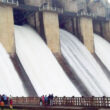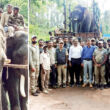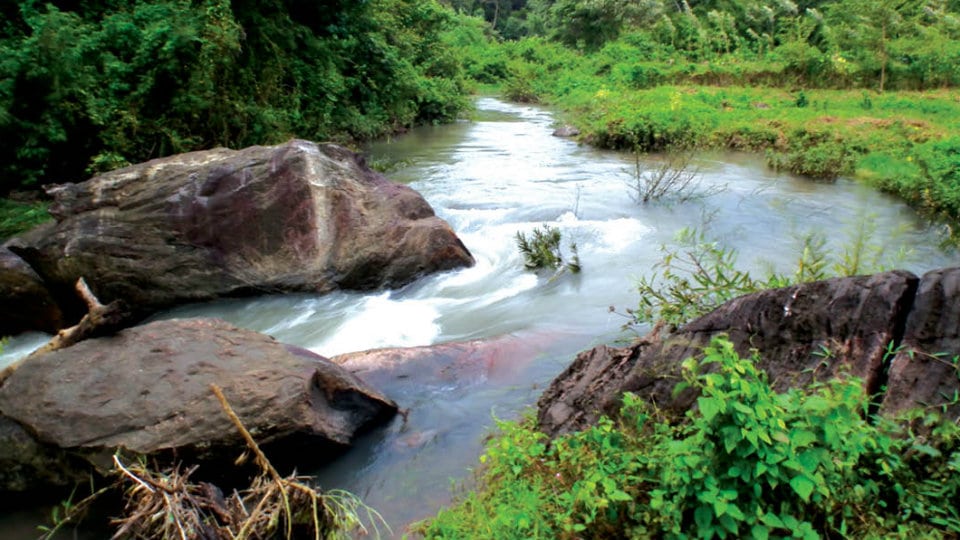By Col. (Retd.) C.P. Muthanna
Kodagu landscape is dominated by forests, coffee estates, paddy fields, sacred groves, rivers and streams. It is inhabited by a number of local communities who are like animals in the forests and just as these animals they too will disappear if forests are destroyed. This is because these communities are very small in number and Kodagu is their only real home.
Importance of Kodagu to South India
Kodagu is the catchment for River Cauvery. Over 70% of the total inflow into KRS Dam is from Kodagu. The river is fed by numerous streams and rivulets that flow from the forests, coffee plantations and Paddy fields. Cauvery is the life-line of South India and provides food, water and economic security for the entire region. It provides water to 8 crore people and 600 major industries. Hence protection of Kodagu as the catchment of Cauvery is extremely critical.
Threats: It is a matter of deep concern that the Kodagu landscape is under serious threat due to a number of factors:
Urbanisation: Since the past ten years, about 2,800 acres of coffee plantations and paddy fields in Kodagu have been converted for commercial purposes. Towns in Kodagu are rapidly expanding and new layouts are coming up in between the towns. The layouts also expand and towns start to join each other and become larger towns.
We may soon have two large cities one in South Kodagu comprising Virajpet-Gonikoppal- Ponnampet and another in North Kodagu comprising Kushalnagar and surrounding areas. It is also of concern that in several cases, the layouts are formed without any conversion or approval. Much of the land conversion is due to greed.
Land use in Kodagu must be regulated to provide housing facilities and infrastructure for the existing population and not to cater for the needs of thousands of people from outside the district to make Kodagu their home. In this regard it is indeed a shame for anyone to convert agriculture or plantation land to sell them as sites, layouts and resorts. If Kodagu itself is gradually converted to one big city, how will there be enough Cauvery water?
Tourism: For Kodagu, tourism has become a huge curse. Much of the degradation of the landscape is due to uncontrolled tourism. With a population of just about 5.5 lakhs, Kodagu received over 13 lakh tourists last year. Resorts consume huge amount of water. The district administration has restricted digging of borewells in Kodagu and also pumping of water from rivers. It should instead see that all resorts are closed down during summer months. Some of the plush resorts in Madikeri and Galibeedu get water from a borewell close to the Kootu Pole, Madikeri’s only water source, and poor residents have to pay for tankers to supply water to their houses during summer. Some resorts have also blocked the flow of water of natural streams.
Home stays: No more licenses should be issued for new home-stays. Even in the case of existing home-stays, the owners to try and keep their home-stays closed during peak summer months unless the income from the home-stay is absolutely essential to meet the expenses of the family. Tourism results in traffic jams, garbage, rising prices, water stress and land conversion for resorts etc. Influx of tourists also disturbs wildlife and increases elephant attacks.
PROJECTS THROUGH KODAGU
400 KV high-tension power line: The Mysore-Kozhikode 400 KV power line resulted in the loss of over 54,000 trees in Kodagu. Other projects such as the Karike Hydro electric project have also resulted in loss of tree cover. Now several more thousands or lakhs of trees are to be felled for railway lines and national highways and for the Kongana river project. In many cases the projects are for the benefit of the neighbouring State of Kerala.
Railway lines: There are two railway lines proposed through Kodagu. One is in the North to connect Mysore-Kushalnagar and Makkandur near Madikeri. The second one is in the South to connect Wayanad in Kerala via Virajpet. Both these projects will spell disaster to Kodagu and must be stopped. Even if the railway line in the North is terminated at Kushalnagar, it will be like opening the door of the house. There will be huge influx of outside immigrants to Kodagu especially Bangladeshis claiming to be Assamese. Our MP Pratap Simha says that the rail link to Kushalnagar is to fulfil a long-standing demand of the people of Hunsur and Periyapatna. This is difficult to understand since people from Hunsur and Periyapatna can conveniently reach Kodagu by road.
National Highways: There are proposals to widen the existing roads in Kodagu to National Highways. The existing traffic density does not warrant such road widening and they only seem to be scams for money making and looting timber from Kodagu. The airport at Mattanur and defence-related traffic from Mangalore Port are given as the reasons but these do not seem to have any logic and are only to fool the people. Road widening will automatically increase traffic, push up land prices along the roads and will accelerate the pace of urbanisation. Certain towns such as Murnad may be totally destroyed.
Sand mining: Sand mining in Kodagu is rampant and there is a need to curb the movement from sand outside the district. The large-scale urbanisation in Kodagu is also a cause for large scale sand mining of Kodagu rivers. It is sad to see the plight of the Lakshmanatheertha River that has been totally destroyed by sand mining. The result is that locals who require sand for genuine purposes have to pay exorbitant prices for sand.
Opposition to environmentalists: It is unfortunate that there are a group of people in Kodagu who are totally opposed to environmentalists in Kodagu and who always object to any measures that could protect the Kodagu environment and landscape. They term all environmentalists as fake environmentalists who are thriving on foreign funds.
These people have opposed any move to protect Kodagu such as Greater Talacauvery Wildlife Sanctuary, Buffer Zone to Nagarahole National Park, UNESCO Heritage Site for Western Ghat Forests of Kodagu, recommendations of Madhav Gadgil report and recommendations of Kasturirangan Report. However, they are fully in support of 400 KV power line through Kodagu, railway line, Barapole hydro project, etc.
Our Home Minister and Minister in-charge of Kodagu district declared that he would not allow even one inch of Kodagu to be designated as Eco Sensitive Zone. When he declares that he will not allow even one inch of Kodagu to be declared as Eco Sensitive Zone, he is actually saying that he, with origins in Kerala, will not allow even one inch of Kodagu to be protected. This is our situation!
We need to develop in a sensible manner so that there is encouragement for coffee production, agriculture, etc. and the land, culture and traditions of the indigenous communities are protected while ensuring their financial security.
Some people want to keep on harping about development in Kodagu. I want to ask them how Kodagu was 25 years ago and how it is today. At this rate of destruction, what will be the fate of Kodagu 10 years from now? The Cauvery in Kushalnagar runs black with filth. The Lakshmanatheertha has been killed by sand mining. Lakhs of trees have been felled. The beautiful paddy fields of Kodagu have become ugly sites and layouts. Even sacred groves are not being spared. When will development in Kodagu be complete? When all the trees have gone? When all the rivers and streams are killed by pollution and sand mining? When Kodagu becomes a huge slum and the indigenous communities are totally marginalised and gradually destroyed?
Madhav Gadgil Report
During 2011, The Western Ghats Ecology Experts Panel under Prof. Madhav Gadgil had recommended that all the three Taluks of Kodagu should be declared as an Eco Sensitive area. The Government then set up the Kasturirangan High Level Western Ghats Panel to review the Madhav Gadgil report. At that time, Coorg Wildlife Society had made recommendations to the Kasturirangan Committee where we had asked for the Madhav Gadgil Panel recommendations to be implemented with certain modifications.
If our politicians had agreed to the recommendations with certain conditions, we would not have been in this terrible state today. We could have avoided the Kerala power line and Kongana Project and Railway link through Kodagu and we would not have seen this amount of dirt and garbage. However, the elected representative warned people against this report and opposed it vehemently.
The total money for the railway lines and national highways would be perhaps over Rs. 3,000 crore. While thousands of crores are available to destroy Kodagu, marginalise indigenous communities and degrade the flow of River Cauvery, there is no money to mitigate human elephant conflict, to establish Ecological Unit for Kodagu, to restore the degraded Kodagu forests and to provide financial security to the communities of Kodagu for protecting the Kodagu landscape. We have to unite to fight this injustice.
What is the way forward?
Kodagu must be protected to ensure that Cauvery can provide sufficient water for downstream users. The Kongana River project is being planned because there is insufficient water in Lakshmanatheertha to sustain Hunsur. The Kongana Dam will again result in the submergence of more land in Kodagu, further destroying green cover. This will increase human-animal conflict and further reduction in rainfall. This will again result in demands for more projects for building dams in Kodagu.
If Kodagu continues to be exploited in this manner, the day is not far away when Kodagu will no longer be the catchment for River Cauvery and River Cauvery itself may cease to have any significant flow. The indigenous communities will also be headed for extinction due to the destruction of their homeland.
If we do not take strong and urgent action, Kodagu will continue to be urbanised and projects through Kodagu will continue to tear through the forests, coffee estates and paddy fields. In another ten to twenty years there will be no Kodagu left. Is this what we want our children to inherit from us?
The fact is that Kodagu will continue to be ravaged until it is totally destroyed. The only hope is to get legal safeguard for Kodagu by having the entire Kodagu district declared as an eco-sensitive area under the provisions of the Environment Protection Act. There is absolutely no other way that Kodagu can be saved.
Kodagu’s environment is important not only for us but also for the residents of the cities down-stream and especially for the poor farmers of Karnataka and Tamil Nadu. Thousands of farmers from Karnataka and Tamil Nadu caught in the web of drought and debt are forced to commit suicide. We must spare a thought for them and for the plight of their families.






